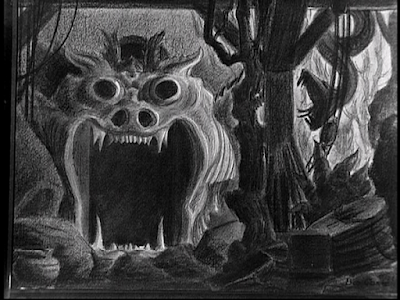 |
| Life magazine photo of Carré at work sketching the begginings of a back drop paiting--I believe on the MGM backlot |
1883-1978
Painter and film art director Benjamin S. Carré was born on this day in Paris, France. Classically trained, Carré studied at the French Atelier Amable and became a professional scene painter for the Paris Opera and moved on to the Comédie-Francais. In addition to scene painting, he was a prolific watercolor artist and painted all through the earliest days of his career, and exhibited the paintings throughout his lifetime. Wanting to get into the film business he managed to find work at Pathé-Gaumont--he worked on several films while still in France, but his name has not survived in the credits to date (perhaps a catalog will turn up with these credits). He came to the United States in 1912 looking for work in the studio system in the New York area. He eventually landed at World Film (& Eclair) working on set painting at the Peerless Studio location. The first film to bear his name for art work was the Clara Kimball Young drama Hearts In Exile in 1915, followed closely by the Albert Capellani film of Dumas' Camille. Once he started working in the business, he had steady work and moved with the studios when they moved west. Most of his career was film was spent during the silent era, though he did work on set into the sound era. He also worked in various aspects of artistic production--costumes to camera work, but mostly he stuck to scene painting, for which he had a tremendous talent. The last silent film that he worked on was the 1929 A. F. Erikson melodrama The Women From Hell staring Mary Astor and Dean Jagger (he had also worked on the Alan Dwan film The Iron Mask --a partial silent--in 1929). He would be away from film for two years, showing back up as art director on the 1931 Charlie Chan film The Black Camel. He would further take off time from film, staying away from film for a full 5 years. He returned in 1936 to serve as art director for three more films, the last being the early film noir Great Guy starring James Cagney. He then retired from the film business and concentrated on his individual paintings. Though he is not credited any later film work, he, according to The New York Times designed the Mount Rushmore backdrops in Hitchcock's North by Northwest, as well art work on Thirty Seconds Over Tokyo. As a member to the Hollywood community, he was also a founding member of the Motion Picture Academy of Art & Sciences. Probably his most famous work was as the designer and painter of the catacombs for the set of the Lon Chaney horror of 1925: The Phantom of the Opera (though, officially, he went uncredited on the project). Carré and his wife Anne, herself a retired performer, stayed in the California for their official retirement. He passed away there on the 28th of May in Santa Monica. For such a high profile member of the earliest Hollywood film crowd, I can find no information as to his burial or cremation. Highly collectable and in demand, many of his paintings are still sold at auctions. He also penned a memoir of his time in the film business.

No comments:
Post a Comment